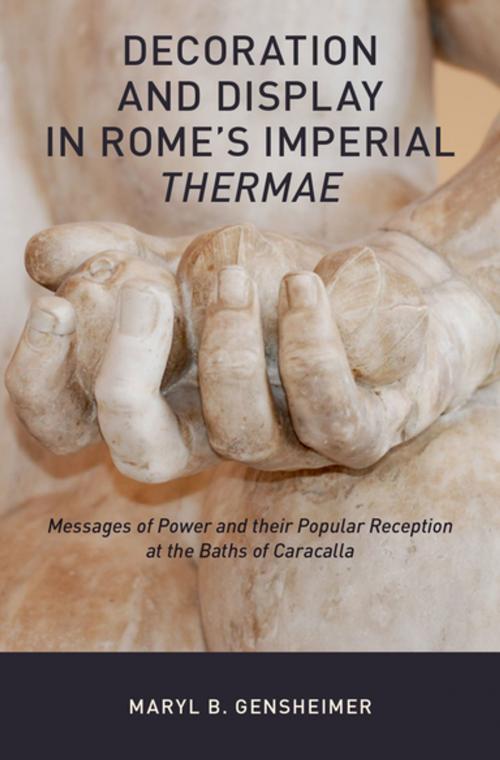Decoration and Display in Rome's Imperial Thermae
Messages of Power and their Popular Reception at the Baths of Caracalla
Nonfiction, Social & Cultural Studies, Social Science, Archaeology, History, Ancient History, Rome, Art & Architecture, Art History| Author: | Maryl B. Gensheimer | ISBN: | 9780190902612 |
| Publisher: | Oxford University Press | Publication: | August 6, 2018 |
| Imprint: | Oxford University Press | Language: | English |
| Author: | Maryl B. Gensheimer |
| ISBN: | 9780190902612 |
| Publisher: | Oxford University Press |
| Publication: | August 6, 2018 |
| Imprint: | Oxford University Press |
| Language: | English |
Across the Roman Empire, ubiquitous archaeological, art historical, and literary evidence attests to the significance of bathing for Romans' routines and relationships. Public baths were popularly viewed as necessities of daily life and important social venues. Given the importance of bathing to the Roman style of living, by endowing eight magnificent baths (the so-called imperial thermae) in the city of Rome between 25 BCE - 315 CE, imperial patrons greatly enhanced their popular and political stature. Decoration and Display in Rome's Imperial Thermaepresents a detailed analysis of the extensive decoration of the best preserved of these bathing complexes, the Baths of Caracalla (inaugurated 216 CE). Maryl B. Gensheimer takes an interdisciplinary approach to existing archaeological data, textual and visual sources, and anthropological theories in order to generate a new understanding of the visual experience of the Baths of Caracalla and show how the decoration played a critical role in advancing imperial agendas. This reassessment of one of the most ambitious and sophisticated examples of large-scale architectural patronage in Classical antiquity examines the specific mechanisms through which an imperial patron could use architectural decoration to emphasize his own unique sociopolitical position relative to the thousands of people who enjoyed his benefaction. The case studies addressed herein--ranging from architectural to freestanding sculpture and mosaic--demonstrate that sponsoring monumental baths was hardly an act of altruism. Rather, even while they provided recreation for elite and sub-altern Romans alike, such buildings were concerned primarily with dynastic legitimacy and imperial largess. Decorative programs articulated these themes by consistently drawing analogies between the subjects of the decoration and the emperor who had paid for it. The unified decorative program--and the messages of imperial power therein--adroitly honored the emperor and consolidated his reputation.
Across the Roman Empire, ubiquitous archaeological, art historical, and literary evidence attests to the significance of bathing for Romans' routines and relationships. Public baths were popularly viewed as necessities of daily life and important social venues. Given the importance of bathing to the Roman style of living, by endowing eight magnificent baths (the so-called imperial thermae) in the city of Rome between 25 BCE - 315 CE, imperial patrons greatly enhanced their popular and political stature. Decoration and Display in Rome's Imperial Thermaepresents a detailed analysis of the extensive decoration of the best preserved of these bathing complexes, the Baths of Caracalla (inaugurated 216 CE). Maryl B. Gensheimer takes an interdisciplinary approach to existing archaeological data, textual and visual sources, and anthropological theories in order to generate a new understanding of the visual experience of the Baths of Caracalla and show how the decoration played a critical role in advancing imperial agendas. This reassessment of one of the most ambitious and sophisticated examples of large-scale architectural patronage in Classical antiquity examines the specific mechanisms through which an imperial patron could use architectural decoration to emphasize his own unique sociopolitical position relative to the thousands of people who enjoyed his benefaction. The case studies addressed herein--ranging from architectural to freestanding sculpture and mosaic--demonstrate that sponsoring monumental baths was hardly an act of altruism. Rather, even while they provided recreation for elite and sub-altern Romans alike, such buildings were concerned primarily with dynastic legitimacy and imperial largess. Decorative programs articulated these themes by consistently drawing analogies between the subjects of the decoration and the emperor who had paid for it. The unified decorative program--and the messages of imperial power therein--adroitly honored the emperor and consolidated his reputation.















